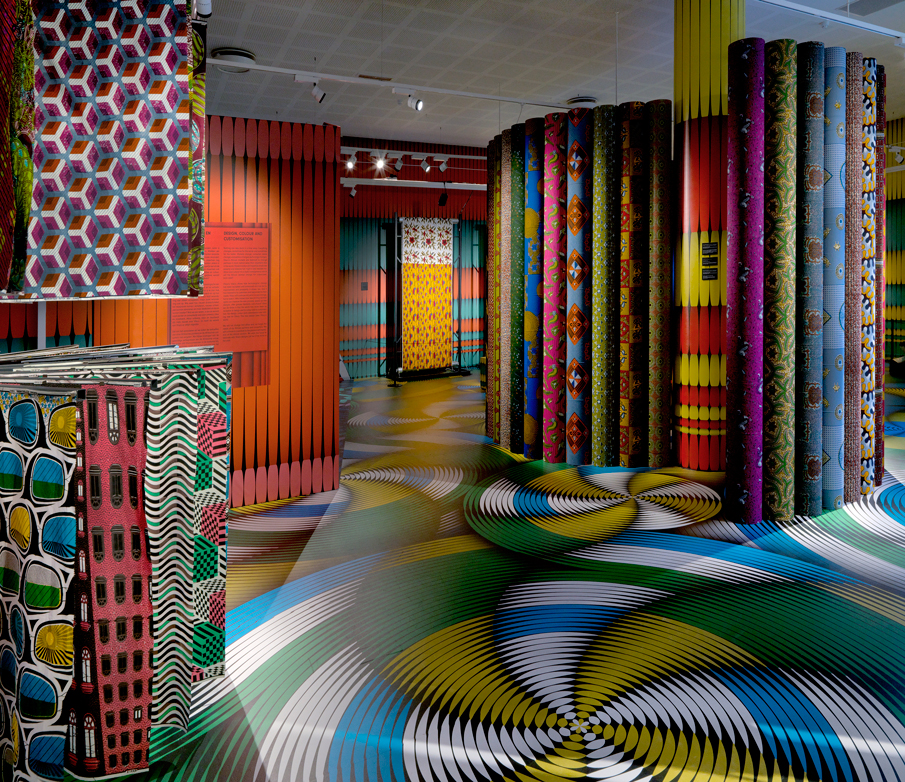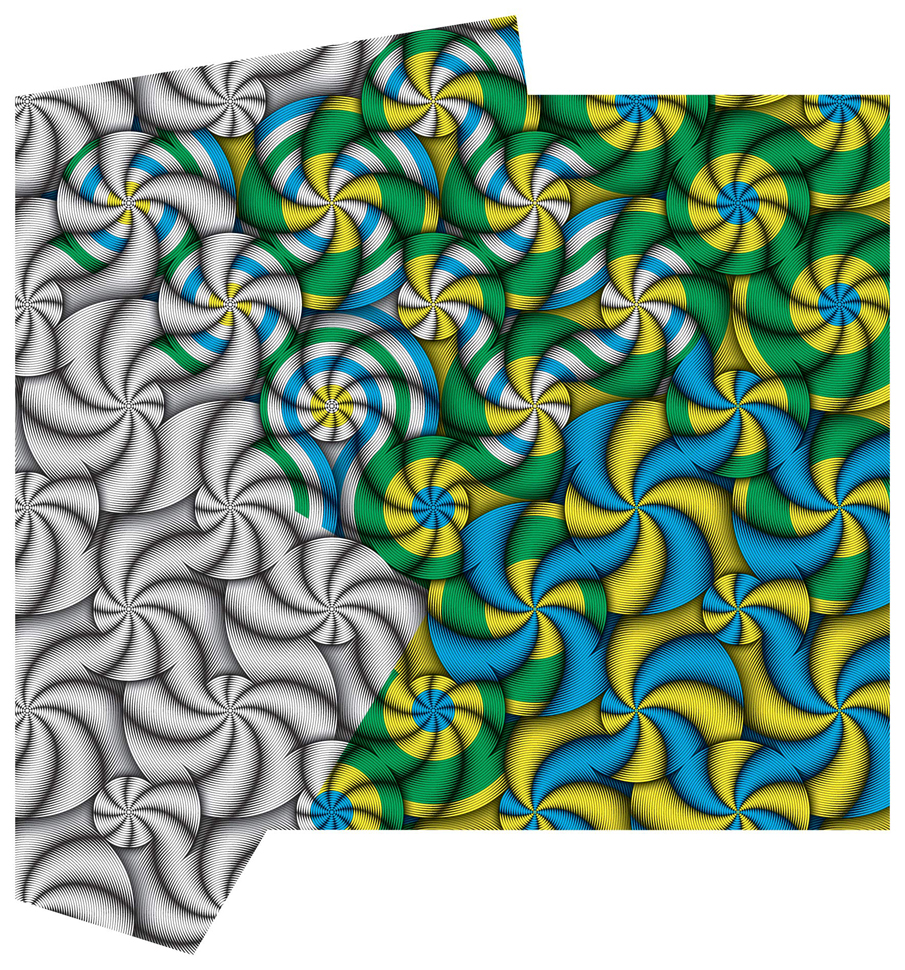title: VLISCO 1:1 EXHIBITION
category: surface design
cooperation with: Studio Harm Rensink
year: 2016
commisioned by: Vlisco Netherlands B.V. and the Gemeente Museum Helmond
Photography: GJ van Rooij
Award: WINNER DUTCH DESIGN AWARDS 2017
Vlisco 1:1 Exhibition

title: VLISCO 1:1 EXHIBITION
category: surface design
cooperation with: Studio Harm Rensink
year: 2016
commisioned by: Vlisco Netherlands B.V. and the Gemeente Museum Helmond
Photography: GJ van Rooij
Award: WINNER DUTCH DESIGN AWARDS 2017
This was one of my highlights of 2016 - making an exhibition design together with Harm Rensink and the Vlisco team. There is a really nice interview with us on Grafik. Here is my part of the interview:
WAX WORKS
written by Anna Lisa Reynolds
The bright, graphic patterns of wax fabrics popular in West and Central African culture have long been a source of inspiration to artists and designers the world over. For the uninitiated, though, it might come as a surprise to learn that the first of these distinctive roller-printed textiles came to Africa by way of the Netherlands and Indonesia. Vlisco, founded by Pieter Fentener van Vlissingen in Helmond in 1846, originally exported imitation batik fabrics to the islands then known as the Dutch East Indies, but soon found a more fertile market for its bold designs in West Africa (helped, no doubt, by the popularity of its Indonesian fabrics with Ghanaian soldiers returning home from postings with the Royal Netherlands East Indies Army). Vlisco began adapting its designs, under the influence of their local trading partners in this flourishing new market, and its famous Dutch Wax textiles were born.
In the intervening years, Vlisco textiles have come to embody a creative dialogue between the Netherlands and Africa, building an extensive archive of colourful and symbolic designs. This year, to celebrate its 170th anniversary, Vlisco has created an exhibition, Vlisco 1:1 / UN a UN, at the Gemeentemuseum Helmond, which explores the history of the company and its archive, and tells the stories of the remarkable African women who had such a profound influence on its products and its success. Designed by Studio Harm Rensink, with surface design by Michiel Schuurman, 1:1 / UN a UN is an immersive riot of colour and pattern that places visitors within the world of Vlisco, and sheds light upon the ways in different cultural influences collide and are assimilated into each other, within fashion and beyond. We caught up with both Rensink and Schuurman to discover the ideas and processes that came together to create the exhibition.

Michiel Schuurman is a Dutch graphic and textile artist. He studied at Koninklijke Academie voor Beeldende Kunsten in Den Haag and the Rietveld Academy, and set up his own studio in 2005. Schuurman used to work for Vlisco, and brought his understanding of the company's history and design process to his own designs for the floor and wall treatments and typography of Vlisco 1:1 / UN a UN.
Tell us about your collaboration with Vlisco, Harm and the rest of the project team on the exhibition...
My collaboration with Vlisco goes back to when I was employed there, so for me it was really easy to grasp what Vlisco is all about. In my first talk with Zara (Atelj, Vlisco creative director) about the exhibition design, I asked whether I could go 'completely crazy' with the surface design and she said “yes please”. That is unique, because she knows that 'crazy' in my case means patterns that are often optical illusions...not always so friendly to the eye and brain. To have a creative director that wants to push those boundaries is almost unheard of in bigger corporations these days. Most companies want patterns that 'sell' and are proven to be a commercial success. Vlisco is at the frontier when it comes to trying out new things, in that respect. I like working for Vlisco because their design process never starts with a visual briefing. It starts with storytelling; Vlisco wants the designers to tell stories with their patterns. That always makes discussing sketches and concepts a delight. It is much more about fantasy and imagination than shapes or pictures.
My collaboration with Harm came at a later point. I immediately liked him and his team and I could see why they were hired for the job. No minimalistic approaches here. I felt a direct connection not only to his taste but also to the 'hands on' mentality which is necessary to finish off big projects. Harm is also a person that keeps a optimistic point of view at all times, which is very refreshing and inspiring to work with under occasionally difficult circumstances concerning time and technical difficulties.
Finally, I have to mention Erwin Thomasse, who was a point of reflection for me during the process. We worked together for four years as colleagues, and his points of view and remarks are of a huge value to me. He is able to put my work in a historical context, and will also be honest when he thinks the quality of a certain feature could be improved. (continued below)











What were you trying to achieve with the surface design?
I wanted to immerse the visitors in a typical Michiel Schuurman/Vlisco pattern. I also made sure that the pattern was black and white in the beginning, so that the process of the fabrication of the fabrics is reflected in the surface design. I did have to make one concession though: I could not technically copy the rich colour of Vlisco's indigo, so I had to use black for the drawing instead. Every test I did trying to imitate the indigo failed miserably…a sign that the dye used by Vlisco is truly unique and a token of quality. (continued below)
I wanted to immerse the visitors in a typical Michiel Schuurman/Vlisco pattern. I also made sure that the pattern was black and white in the beginning, so that the process of the fabrication of the fabrics is reflected in the surface design. I did have to make one concession though: I could not technically copy the rich colour of Vlisco's indigo, so I had to use black for the drawing instead. Every test I did trying to imitate the indigo failed miserably…a sign that the dye used by Vlisco is truly unique and a token of quality. (continued below)





You used to work at Vlisco—how did this experience inform your work on Vlisco 1:1 / UN a UN?
As I said earlier, working for Vlisco feels like a warm bath. It also meant that my patterns are not a cliche; I just simply went on with my normal Vlisco process. I think that if they hired a designer from outside the company, the pattern would be more like a pastiche of Vlisco elements. My pattern truly feels like a Vlisco original.
Do you have any particular favourite parts of the show or features that you feel worked particularly well?
I just like the whole maximalistic approach. Just a bunch of truly creative people hanging out, with no commercial hindrance, makes for a truly radical exhibition. (end of interview)


